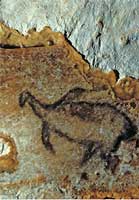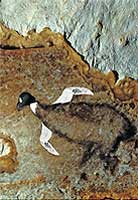 Plate 17 Plate 17
|
 Plate 18 Plate 18
|
|
Mediterranean Auks in an Underwater Cave
Art
n 1985, while deep-sea diving 110 feet (35 meters)
below the surface at Cape Morgiou, near Marseilles, France, Henri Cosquer
discovered the small entrance to a cave. Venturing 450 feet (135 meters)
inside, he discovered an expansive, air-filled chamber. When he returned
six years later, he discovered the chamberís gallery of Paleolithic cave
art, including this outline of what appears to be a Great Auk (Pinguinus
impennis), painted with charcoal on a vaulted ceiling not far from two
smaller images that also appear to be Great Auks.
Science
The underwater entrance presented two obvious questions. What was this decorated cave doing in deep water? Could the pictures in its gallery possibly be authentic? The story that emerges from subsequent research is almost as remarkable as the art. Assessments of the tiny, slow-growing calcite crystals coating the images established that the images had been painted at a much earlier time and were therefore authentic. When the Paleolithic artists painted in the cave, it appears that they were working on a cliff some 250 feet (75 meters) above the Mediterranean shoreline and several miles inland. The explanation for the dramatic shift in the
page 2--> |
Plate 17 Auk in Cosquer Cave,Alpes Maritimes, France, c. 17,000-16,000 BCE. Charcoal on rock wall. © Photo: J. Clottes. In J. Clottes, J. Courtin, and L. Vanrell, Cosquer Redécouvert (Paris: Le Seuil, 2005). Science Art--Birds.
Plate 18 Modified Detail of Auk in Cosquer Cave,Alpes Maritimes, France, 2005/2007, by Darryl Wheye.
© Darryl Wheye. Science Art-Birds
© 2008 Darryl Wheye and Donald Kennedy
|

 Plate 17
Plate 17  Plate 18
Plate 18